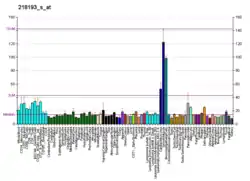GOLT1B
Vesicle transport protein GOT1B is a protein that in humans is encoded by the GOLT1B gene.[5][6][7]
| GOLT1B | |||||||||||||||||||||||||
|---|---|---|---|---|---|---|---|---|---|---|---|---|---|---|---|---|---|---|---|---|---|---|---|---|---|
| Identifiers | |||||||||||||||||||||||||
| Aliases | GOLT1B, GCT2, GOT1, GOT1B, YMR292W, CGI-141, golgi transport 1B | ||||||||||||||||||||||||
| External IDs | OMIM: 615078 MGI: 1914214 HomoloGene: 41102 GeneCards: GOLT1B | ||||||||||||||||||||||||
| |||||||||||||||||||||||||
| |||||||||||||||||||||||||
| |||||||||||||||||||||||||
| |||||||||||||||||||||||||
| Orthologs | |||||||||||||||||||||||||
| Species | Human | Mouse | |||||||||||||||||||||||
| Entrez | |||||||||||||||||||||||||
| Ensembl | |||||||||||||||||||||||||
| UniProt | |||||||||||||||||||||||||
| RefSeq (mRNA) | |||||||||||||||||||||||||
| RefSeq (protein) | |||||||||||||||||||||||||
| Location (UCSC) | Chr 12: 21.5 – 21.52 Mb | Chr 6: 142.39 – 142.4 Mb | |||||||||||||||||||||||
| PubMed search | [3] | [4] | |||||||||||||||||||||||
| Wikidata | |||||||||||||||||||||||||
| |||||||||||||||||||||||||
Got1p is a protein that aides in vesicle transport through the Golgi apparatus of the cell.[8] Got1p has a calculated mass of 15.4 kDa and consists of 138 residues. It is believed that the protein is a tetra-spanning membrane protein, and is evolutionarily conserved. Homologes of the protein have been found in Caenorhabditis elegans, Plasmodium falciparum, and in mammals. GOT1 is normally associated closely with Sf2p (encoded by sft2), which is another protein of similar function. In vivo, It has been found that the removal of these two proteins results in defects in endosome-Golgi traffic and ER-Golgi traffic. In vitro, the removal of got1 specifically, results in a defect in ER-Golgi transport in relation to vesicle tethering to Golgi membranes. The exact contribution that the protein has towards vesicle tethering is still a mystery, however, it is suspected that Got1p is involved in the release of Ca2+ in the Golgi membranes, causing ion channels associated with vesicle tethering to be affected.[9]
References
- GRCh38: Ensembl release 89: ENSG00000111711 - Ensembl, May 2017
- GRCm38: Ensembl release 89: ENSMUSG00000030245 - Ensembl, May 2017
- "Human PubMed Reference:". National Center for Biotechnology Information, U.S. National Library of Medicine.
- "Mouse PubMed Reference:". National Center for Biotechnology Information, U.S. National Library of Medicine.
- Bourdon V, Naef F, Rao PH, Reuter V, Mok SC, Bosl GJ, Koul S, Murty VV, Kucherlapati RS, Chaganti RS (Nov 2002). "Genomic and expression analysis of the 12p11-p12 amplicon using EST arrays identifies two novel amplified and overexpressed genes". Cancer Res. 62 (21): 6218–23. PMID 12414650.
- Lai CH, Chou CY, Ch'ang LY, Liu CS, Lin W (Aug 2000). "Identification of novel human genes evolutionarily conserved in Caenorhabditis elegans by comparative proteomics". Genome Res. 10 (5): 703–713. doi:10.1101/gr.10.5.703. PMC 310876. PMID 10810093.
- "Entrez Gene: GOLT1B golgi transport 1 homolog B (S. cerevisiae)".
- Connerly, PL (2010). "How Do Proteins Move Through the Golgi Apparatus?". Nature Education. 3 (9): 60.
- Conchon S, Cao X, Barlowe C, Pelham HR (July 1999). "Got1p and Sft2p: membrane proteins involved in traffic to the Golgi complex". The EMBO Journal. 18 (14): 3934–46. doi:10.1093/emboj/18.14.3934. PMC 1171469. PMID 10406798.
Further reading
- Conchon S, Cao X, Barlowe C, Pelham HR (July 1999). "Got1p and Sft2p: membrane proteins involved in traffic to the Golgi complex". The EMBO Journal. 18 (14): 3934–46. doi:10.1093/emboj/18.14.3934. PMC 1171469. PMID 10406798.
- Wiemann S, Weil B, Wellenreuther R, Gassenhuber J, Glassl S, Ansorge W, Böcher M, Blöcker H, Bauersachs S, Blum H, Lauber J, Düsterhöft A, Beyer A, Köhrer K, Strack N, Mewes HW, Ottenwälder B, Obermaier B, Tampe J, Heubner D, Wambutt R, Korn B, Klein M, Poustka A (March 2001). "Toward a catalog of human genes and proteins: sequencing and analysis of 500 novel complete protein coding human cDNAs". Genome Research. 11 (3): 422–35. doi:10.1101/gr.GR1547R. PMC 311072. PMID 11230166.
- Simpson JC, Wellenreuther R, Poustka A, Pepperkok R, Wiemann S (September 2000). "Systematic subcellular localization of novel proteins identified by large-scale cDNA sequencing". EMBO Reports. 1 (3): 287–92. doi:10.1093/embo-reports/kvd058. PMC 1083732. PMID 11256614.
- Matsuda A, Suzuki Y, Honda G, Muramatsu S, Matsuzaki O, Nagano Y, Doi T, Shimotohno K, Harada T, Nishida E, Hayashi H, Sugano S (May 2003). "Large-scale identification and characterization of human genes that activate NF-kappaB and MAPK signaling pathways". Oncogene. 22 (21): 3307–18. doi:10.1038/sj.onc.1206406. PMID 12761501.
- Clark HF, Gurney AL, Abaya E, Baker K, Baldwin D, Brush J, Chen J, Chow B, Chui C, Crowley C, Currell B, Deuel B, Dowd P, Eaton D, Foster J, Grimaldi C, Gu Q, Hass PE, Heldens S, Huang A, Kim HS, Klimowski L, Jin Y, Johnson S, Lee J, Lewis L, Liao D, Mark M, Robbie E, Sanchez C, Schoenfeld J, Seshagiri S, Simmons L, Singh J, Smith V, Stinson J, Vagts A, Vandlen R, Watanabe C, Wieand D, Woods K, Xie MH, Yansura D, Yi S, Yu G, Yuan J, Zhang M, Zhang Z, Goddard A, Wood WI, Godowski P, Gray A (October 2003). "The secreted protein discovery initiative (SPDI), a large-scale effort to identify novel human secreted and transmembrane proteins: a bioinformatics assessment". Genome Research. 13 (10): 2265–70. doi:10.1101/gr.1293003. PMC 403697. PMID 12975309.




